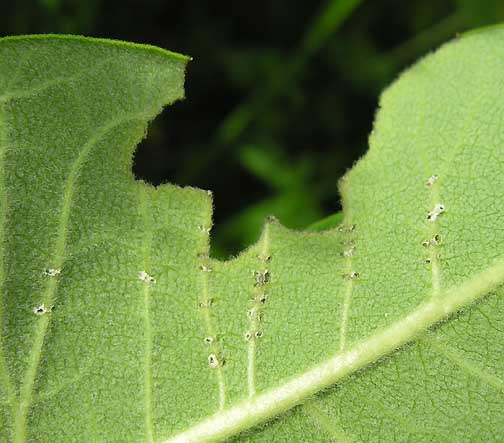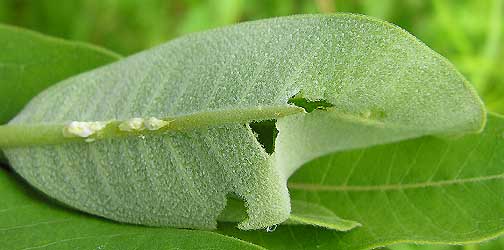June 24th, 2006
those ingenious insects
In recent days, I’ve been spending quite a bit of time examining milkweed leaves while looking for insects and spiders. One of the hazards of working around milkweed is that the sticky milk-like sap, a kind of latex, inevitably gets on your fingers and then onto other things…. like your camera. I’m always ever so careful to move the leaves gently while photographing insects, in the hope that I won’t damage a leaf and set the milk flowing, but somehow I always manage to get the stuff on me.
This week, while reading Thomas Eisner’s For Love of Insects, I discovered at least part of the explanation for why it is that I’ve been so unsuccessful at avoiding the sticky sap. Eisner addresses the feeding strategies of certain insects that hang out on Common Milkweed (Asclepias syriaca) plants. It seems that many of them like to feed on the leaves, but can’t handle the copious amounts of milky sap that flow through the veins – it being both toxic to some creatures, and also so gummy that it can clog up their feeding apparatus. So, in typically ingenious insect fashion, they make cuts or punctures in the veins to halt the flow out to the portion of the leaf they wish to consume (sorry, I don’t have the page reference for this, but it should be easy enough to find as there are accompanying photos).
So, armed with this new piece of knowledge, I immediately went out to the field to do some investigation. I didn’t have to do much looking before finding some excellent examples of leaves which had either been neatly punctured “upstream” of neatly nibbled sections of leaves (see above — click for a larger and much clearer image), or those that had been more brutally cut along a major lactiferous artery. In the latter case, the sap was usually coagulated into a large, white, gloopy ooze, and the outer sections of the leaves were generally quite disfigured from some fairly voracious feeding.
Of course, now I’m turning leaves checking to see which insects are feeding with or without puncturing the leaf veins. I don’t have enough data to comment at this point, but I thought I’d point out the leaf-puncturing activity for others who might be observing insects that are feeding on milkweed at this time of the year. I’ll try to post some follow-up observations next week.
Tags: milkweed, lactiferous, sap, insects, punctures


June 24th, 2006 at 1:58 pm
I love Thomas Eisner’s book, and recall the very section you are referring to, Bev. I was enjoyed the Synchlora section.
It was upon observing one of those caterpillars-in-drag that I was moved to discover his email address and write him with my accolades. Never heard back, but it’s not too surprising. I suspect he’s not an email person despite his emeritus address.
June 24th, 2006 at 2:04 pm
Oh yes, forgot – my introduction to him was from an NPR interview in Nov 2003. I was enchanted by his elderly, quavery voice and his pure “Love for Insects”. It’s a wonderful interview. It made me want to cry.
June 24th, 2006 at 2:06 pm
Listening to it again, his voice isn’t nearly as quavery as I recall two years ago and more. He captured me with his passion.
June 24th, 2006 at 2:58 pm
Wayne – yes, it’s a wonderful book. It contains so much information on a wide range of invertebrates. What struck me while reading the book was that Eisner must have an incredibly curious mind — as in, very investigative. The seemingly simple experiments which he employed to test theories were quite fascinating. I do agree that he must be quite passionate about the study of insects. Thanks for posting the link to the NPR interview. I’ll have to see if I can get it to play on my Mac using a media program.
June 24th, 2006 at 3:04 pm
What truly ingenious behavior. I love knowing this. And now that you’ve introduced me to Eisner, I may have to go find his book. Thanks to Wayne to for that link, too.
June 24th, 2006 at 3:16 pm
RA – I expect you would enjoy Eisner’s book. It’s really quite a fun and interesting read. Difficult to describe, but it’s an odd blend of science, anecdotes, biography, photos, and also quite humorous at times. It deals mainly with Eisner’s work on chemicals released by insects, so a lot of it has to do with being sprayed by this or that insect, how a blue jay reacts when he gives it a certain bug, etc… All quite fascinting. The macro photography is excellent. If you’ve ever read anything by Berndt Heinrich (A Year in the Maine Woods, The Trees in My Forest, etc…), it’s a little along the same line — someone with an inquisitive mind that just has to try to discover what’s going on.
June 24th, 2006 at 10:49 pm
Very tricky, great observation Bev.
June 25th, 2006 at 9:07 am
Reading blogs seems to be a way of increasing our library and decreasing the amount of money in our pockets. Thanks to you and Wayne for making this book a must have!
July 9th, 2006 at 10:16 pm
I, too, am examining leaves constantly—I’m doing research on the Aspen Leaf Miner moth, Phyllocnistis populiella. Not as a scientist, however, but as an artist for an upcoming museum exhibit. Perhaps you’d be interested—check out my blog.
July 10th, 2006 at 12:30 am
Hi Eero – I just checked out your post about the Aspen Leaf Miner moth and your images of the leaves. Very interesting and nice blog — in fact, just added it to my blogroll.